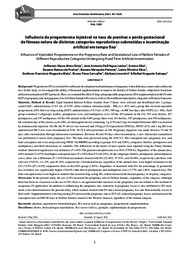Influência da progesterona injetável na taxa de prenhez e perda gestacional de fêmeas nelore de distintas categorias reprodutivas submetidas a inseminação artificial em tempo fixo.
Influência da progesterona injetável na taxa de prenhez e perda gestacional de fêmeas nelore de distintas categorias reprodutivas submetidas a inseminação artificial em tempo fixo.
Author(s): DINIZ, J. V. A.; DELL'AQUA JUNIOR, J. A.; OBA, E.; FREITAS, R. R. de; PEIXOTO, R. M.; SILVA, L. O.; MAIA, G. F. N. M.; CARVALHO, B. P.; LOUREIRO, B.; SATRAPA, R. A.
Summary: Progesterone (P4) is essential for embryonic development and maintenance of pregnancy when deficiency causes early embryonic loss. In this study, we investigated the ability of hormonal supplementation to improve the fertility of Nellore females subjected to fixed-time artificial insemination (IATF) protocols. Here, we evaluated the effect of long-acting injectable progesterone (iP4) supplementation in the D4 after IATF on pregnancy rate and pregnancy loss in Nellore females (Bos taurus indicus) from different reproductive categories in Western Amazonia. Materials, Methods & Results: Eight hundred thirteen Nellore females from 5 farms were selected and distributed into 2 groups: control [GC; administration of 0.5 mL of 0.9% saline solution, intramuscularly - IM] (n = 407) and a group that received injectable progesterone (iP4) that was long-acting [GiP4; administration of 0.5 mL of iP4, 300 mg, via IM four days after IATF] (n = 406). Each group contained 3 subgroups: heifers, primiparous cows, and multiparous cows. Of the 407 animals in the CG, 103 were heifers, 107 primiparous, and 197 multiparous. Of the 406 animals in the GiP4 group, there were 101 heifers, 107 primiparous, and 198 multiparous. On a random day of the estrous cycle (D0), an intravaginal device containing 1 g of P4 and 2 mg of estradiol benzoate (BE) was inserted by intramuscular injection. On D8, the P4 device was removed and 150 μg of D-cloprostenol (PGF2α), 300 IU eCG, and 1 mg BE were administered IM. Cows were inseminated at D10, 48-52 h after procedure on D8. Pregnancy diagnosis was made between 35 and 40 days after insemination through ultrasound examination. Between 80 and 90 days after insemination, a new ultrasound examination was performed to assess early pregnancy loss. The data were processed using the SAS 9.2. The conception rate, pregnancy loss, and final conception rate were analyzed using PROC GLIMMIX according to groups (CG and GiP4), categories (heifers, primiparous and multiparous), and their interactions as variables. The differences in the means of least squares were adjusted using the Tukey?Kramer method. Statistical significance was defined as P < 0.05. The general conception rate was 46% (375/816). Regardless of the animal class, GiP4 animals (51.97%) had higher conception rates (P < 0.05) than CG (40.29%). In the subgroups (heifers, primiparous and multiparous cows), there was a difference (P < 0.05) between animals treated with iP4 (52.48%, 57.94%, and 48.48%, respectively) and those who were not (39.81%, 41.12%, and 40.10%, respectively). Gestational losses, regardless of the animal class, were higher in females in the CG (7.93%) [P < 0.05] compared to those in the GiP4 group (2.84%). Regardless of treatment with iP4, the percentage of gestational loss in heifers was significantly higher (10.64%) than that in primiparous and multiparous cows (3.77% and 2.86%, respectively). The final conception rates were higher in animals that received long-acting iP4, which increased the final pregnancy in all parity categories. Discussion: In the present study, the use of iP4 increased the pregnancy rate in Nellore females, regardless of the category. Although there has been no consensus on the use of iP4, there is an agreement that increases in the pregnancy rate are related to the moment of exogenous P4 application. In addition to influencing the pregnancy rate, reduction in pregnancy losses is also attributed to iP4 treatment, a fact demonstrated in the present study, where animals treated with iP4 had a lower pregnancy loss rate than normally occurs in beef cattle. Supplementation with long-acting iP4 increased the pregnancy rate at D35-40, reduced pregnancy losses, and increased the conception rate on D80-90 days in Nellore females reared in the Western Amazon, regardless of the animal category.
Publication year: 2021
Types of publication: Journal article
Unit: Embrapa Acre
Keywords: Animal breeding, Animal fertility, Animal reproduction, Artificial insemination, Beef cattle, Beef cows, Breeding methods, Fertilidad animal, Fertilidade Animal, Gado Nelore, Gado de Corte, Ganado de carne, Hormonas progestacionales, Hormônio, Inseminación artificial, Inseminação Artificial, Métodos de mejoramiento genético, Nellore, Ovulación, Ovulation, Ovulação, Prenhez, Progestational hormones, Progesterona, Progesterone, Reproducción de animales, Reprodução Animal, Vaca de Corte, Vacas para carne
Observation
Some of Embrapa's publications are published as ePub files. To read them, use or download one of the following free software options to your computer or mobile device. Android: Google Play Books; IOS: iBooks; Windows and Linux: Calibre.
Access other publications
Access the Agricultural Research Database (BDPA) to consult Embrapa's full library collection and records.
Visit Embrapa Bookstore to purchase books and other publications sold by Embrapa.

